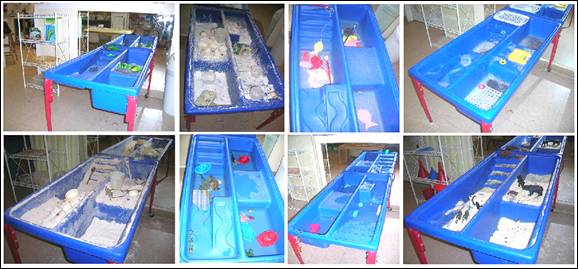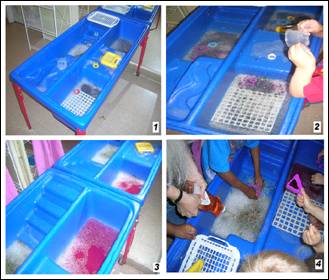Asia-Pacific Forum
on Science Learning and Teaching, Volume 10, Issue 2, Article 14 (Dec., 2009) |
Demonstrations for early childhood educators and science teachers
Be inspired by the Reggio Emilia approach! Appropriating the approach into one's own context enables teachers to reinvent themselves and extend their own children’s lives in a meaningful way without importing artificial, out of context prescribed science curricula. Accordingly, assimilating the Reggio principles (the image of the child, education based on relationships, the role of the teacher, progettazione, inquiry-based curriculum, documentation and the role of the environment and materials) in your context can give children opportunities to construct their knowledge of science while interacting with others.
Aim higher! There is no need to worry about meeting standards or a prescribed formula when following children’s interests and inquiries within the framework of the Reggio Emilia principles. Standards are limited so that they should not become a set of criteria that teachers follow and create curricula. The teachers should aim higher and should be careful about challenging children at their own level, not a level prescribed by so-called experts. It is also necessary to remember that the child is intelligent, strong, beautiful and ambitious (Malaguzzi, 1994). Teachers should aim higher with such strong image of the child, rather than aim lower with the traditional child image, which is weak and needy.
Take individual needs into consideration! Teachers need to conduct necessary accommodations in the classroom to meet individual differences, needs and interests. Reggio Emilia is not about implementing an artificial program into your context. However, it is about growing a curriculum out of your own context, so that individual needs can be met. Standards mostly do not take into consideration the special needs of some children (e.g., disabilities). However, Reggio Emilia provides a context to challenge a child at his or her level instead of standardized criteria or tests. This is more beneficial and fair for ALL children.
Listen to the child! While shaping the curriculum, teachers should be sure that they are following children’s interests and inquiries! It is essential to build upon children’s interests and inquiries, in order to find the most learning opportunities. Inan (2009a) states that the classroom and the curriculum in Reggio Emilia schools are not static but are responsive to the changing needs and interests of children. She continues, for example, “The teachers were setting up the environment with new materials and tools, changing things/variables at each time” (p. 2515) as seen in the picture below. The picture below demonstrates examples of different sensory table projects over time based on interests of children in a Reggio Emilia-inspired preschool: exploring bugs/insects, measuring things, fishing with magnets, bubble work, exploring sea habitats, water/sticky things and snow animals.
Pay attention to shared interests! While taking individual needs and interests into consideration, it is also essential to pay attention to any shared interests and inquiries of the children. An individual is a part of a community, not just an individual entity.
Do documentation! Teachers should use documentation to enrich children’s learning processes, and inform other people about the children’s learning and development. However, teachers should never use documentation to judge preschoolers and declare them a success or a failure. This is merely labeling little children, a process which may stigmatize and cause harm. Inan (2009b) states that, “teachers’ documentation of children’s work is so informative in terms of showing ‘creativity’ and ‘discovery’ in the projects that Reggio kids produced” (p. 1377).
Balance peer culture and school culture! Inan (in process) states that while Reggio Emilia-inspired teachers may not target early childhood science education standards, they often meet them as children engage in meaningful, authentic science experiences in project-based, emergent curricula that emphasize inquiry, in-depth understanding, engagement, and group learning. In order to accomplish this in their classrooms, teachers should take both school culture (e.g., general educational objectives) and peer culture (e.g., children’s current interest in spiders) into consideration when determining the emerging curriculum. Teachers should be able to turn children’s excitement over a topic into a learning opportunity.
Take action! Teachers can rethink their knowledge of child development and revisit their documentation. Based on what appears, they can set up an environment that stimulates children’s learning and provides assistance as needed.
Support hands-on, heads-on, hearts-on experiences! Teachers should consider children’s whole development. They should provide a context in which children can follow their inquiries and interests, construct their knowledge of science through hands-on experiences, and have a love of the subject matter.
Be flexible! Teachers should never stop listening to children and always be ready to make curriculum changes any time. As the curriculum emerges, it is essential to make changes according to the shifting interests of the children.
Lastly, Benefit from Turkish national education standards properly! Standards will be beneficial for children and teachers only if they are used properly. Teachers should avoid problems, which are given under limitations of the standards, so that high quality education can be achieved.



